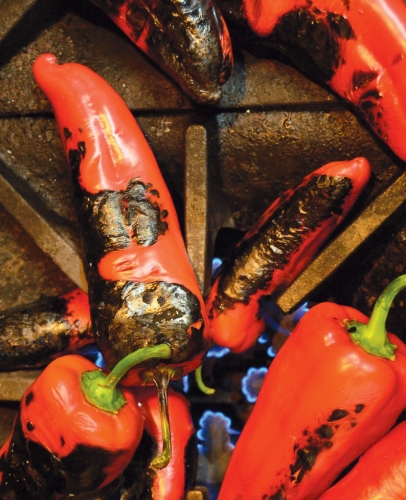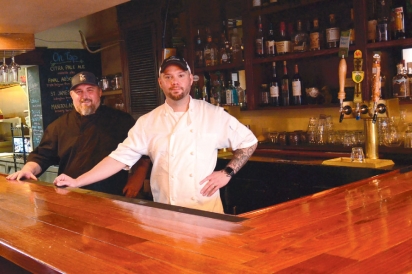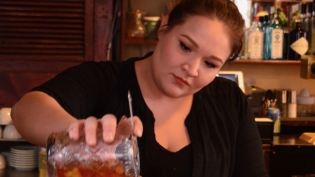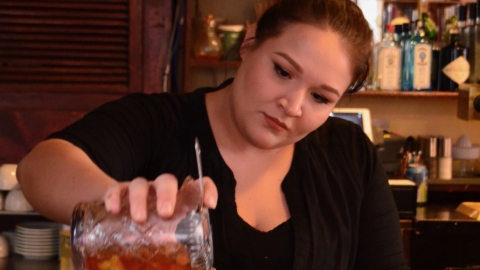Wren: The New Place in Town
Partway down the short stretch of M-22 that is Main Street in Suttons Bay stands an old building with a new restaurant inside—though you wouldn’t easily know by driving past. As recently as October, the sign out front on the historic, painted red brick firehouse still said 9 Bean Rows. But inside, chef and new owner Adam McMarlin can be found every day, chopping and cooking for the day’s dinner menu of the newly hatched restaurant named Wren.
The sign will remain until Adam finds an artisan to design something new to replace it. There’s no rush. More importantly, Adam has a restaurant to manage, food to purchase, menus to tweak, a kitchen to make his own. Business has been fine. People are finding their way to his tables. Signs can wait.
Adam opened Wren on the first of August, after a whirlwind business transfer with Jen and Nic Welty, owners and managers of 9 Bean Rows farm, bakery and—now formerly—restaurant. The idea was born from a moment’s chat between Adam and Jen during a special event on the third of July. That idea became reality in less than 30 days.
Two and a half months into this new venture, Adam is feeling pretty good about things. He’s opted for the rhythm of serving dinner Tuesday through Saturday, allowing him to focus on both the restaurant’s needs and his family—wife, Kaley, and their two daughters, aged 2 and 4. At 35, he’s got nearly 15 years in the business, which shows as he gets to work prepping squash and peppers, checking on a simmering pot of stock with onion peels peeking out the top. His movements are assured and compact, taking my invasion of his workspace in stride.
A typical night at Wren might have 12–20 reservations on the books, but end up serving 35 guests. Walk-ins are welcome, particularly if you avoid the crush time of 6:30–7:30, as finding the number to call for reservations has been a challenge (hint, it’s the old 9 Bean Rows’ restaurant number—231-271-1175—not the number for his former downtown Traverse City business, Wren the Butcher, now closed). There’s a good mix of first-time guests and repeats, the latter including noted local food luminaries chefs Pete Peterson (formerly of Tapawingo and Alliance) and Mario Batali, each in to eat four times in the first six weeks the restaurant was open.
From day one Adam has taken inspiration from the local produce and quality ingredients to which he has access through his suppliers: 9 Bean Rows Farm, Loma Farm and Grand Traverse Mushrooms, as well as Oryana Community Co-op in Traverse City where he gets product from Second Spring, Providence and Meadowlark Farms, and Food for Thought. It’s one of the reasons he chose to own a restaurant in Leelanau County, and what makes being a chef that much more interesting. In his very first job he worked at a butcher shop, grocery, fruit market, fish counter in Clinton Township downstate. The shop was owned and run by a couple of Italian brothers. “People would come from Bloomfield Hills to shop there. The brothers would go to the Eastern Market in Detroit every morning to get stuff for the store. I was only a kid in high school, in my first job, but I learned a lot working there.”
A recent find that he’s enjoyed playing with is Carmen peppers: fire-engine red, shaped like a bull’s horn, with thick flesh and a bright, sweet flavor. Both Loma and Meadowlark have them this season. Adam toasts them over a flame, removes the skins and, the night I was there, he prepared them as a romesco sauce to accompany rainbow trout with coriander butter and a fennel and Jonamac apple salad. He tells me he’s looking forward to local farmers and producers coming by to see if he’d like to buy their chickens, or strawberries, or microgreens, or whatever else they are excited about. Having rid the kitchen of its freezer, he’s living his belief in cooking fresh.
Menu planning is daily, beginning after each night’s shift, and concluding just before service. Each day presents something different, be it gift or obstacle. An expected delivery might come at 6:30 rather than 2. Oryana might be out of local green beans. The walleye might be one and a half pounds apiece or ten ounces. “I don’t even know how many incarnations of my menu I’ve done since I’ve been here. Small changes probably three times a week. Some nights it’s, like, 4:30 before I have the menu nailed down. That’s why we print them here. I just tell Hanna [bartender and head of the front of the house] when she comes in and she puts the changes in and prints them out.”
In the past couple of months Adam has acquired a core team of five employees. His sous-chef Brad Hoog, an experienced farmer/cook who’s chosen to come back into the kitchen after a ten-year hiatus, also works part time for Jen Welty at 9 Bean Rows Bakery; Hannah Madagame, held over from the 9 Bean Rows restaurant, the creative spirit behind the house drinks list who keeps the bar humming along and manages out front; Annalise Buhr, also from the prior 9 Bean Rows team out front; and in September Ivy Ballie and Katie Wagner (level 2 sommelier for spirits) joined the crew.
“Our team is really awesome,” says Hanna. “We’ve been super lucky to find the people we have so fast. Everyone is passionate about what’s going on. Katie brings her knowledge of spirits, and both she and Ivy have worked in farm-to-table settings before.”
Discussing his team, Adam remarks, “If the six of us can’t figure out what to do, we shouldn’t be doing this. It’s all about flexibility. No freak-outs. Just cope, adjust, problem solve. It mostly only goes wrong in a kitchen. So really, you shouldn’t be surprised, no matter what comes up. I don’t know what tomorrow will be like. It doesn’t matter now. I don’t worry about something ‘til it’s time to worry about it.”
On the night my friend and I dined at Wren, a Wednesday in early October, Adam and Brad were in the kitchen, Hanna at the bar, and Ivy juggling the dining room on her own quite competently, eager to answer all our questions, and confirm the ingredients in the dishes so that we could avoid anything to which my friend is allergic. We ordered the charcuterie platter*, with its three options: duck liver pâté, pork country pâté and salmon tartare, the first two with crunchy tart pickled vegetables atop them. The portions were generous, the flavors and textures perfect. When I asked Adam for his duck liver pâté recipe, he spoke it to me as he continued prepping the squash for that evening’s chicken dish (recipe follows).
Reflecting, Adam shares that he’s had many an uncertain moment these past couple of months: “It’s hard not to be self-conscious. We jumped into it so quickly, and so short-staffed. A new kitchen can make you look like you’ve never cooked before. It takes me at least two weeks to get comfortable in a new kitchen. It’s always taken me that long to put things where it makes sense for me, for me to get my mise en place fixed from whatever was there before. I’m really particular.”
In the meantime, he’s doing what he does well, and going about it thoughtfully, honing his business skills and paying attention to resources. “So far, we’ve had very little waste. I think I might have had to toss some pork rillettes once. That’s it. I can count on 12 to 45 guests in a night, so I try to have eight to ten of each dish. If I run out of trout at 8:30, that’s good. I want to run out of fish.”
Speaking of fish, Hanna shares with me that Adam plates his rainbow trout whole, rather than as filets. Adam says he wants to remind people that the food on the plate used to be a living thing. This has surprised a few guests, and pushed the staff to work together to explain this to diners. “What’s great about Adam,” Hanna says, “is that he’s making dishes a bit out of peoples’ comfort zone more approachable.” And, according to Adam, “Most people like it, though one person covered the head with a bread plate while they ate it, and some have asked me to remove it [the fish head].” He plans to continue this experiment.
Hanna is clearly invested in her role as bartender and guiding the front of the house. She explains to me how inspired she is by the abundance of offerings she is surrounded by here. Proud of her native heritage (her great-great-grandfather was a member of the Grand Traverse Ottawa and Chippewa tribe and she bears his name, which means rushing river), she wants to incorporate as many locally made and - grown ingredients into her offerings as she can. She’s been working with Dennis Fitzpatrick (noted local wine expert and Adam’s father-in-law) to revamp the wine menu, adding more local wines and some new reds. With the change of seasons, she’s designing new cocktails, one with dark rum, muddled plum and a topping of sparkling Malbec, another with pear, spices and Grand Traverse Rye Vodka.
As bartender, Hanna enjoys her privileged contact with guests. “One of the things I get to observe is that the people sitting at the bar can see into the kitchen, and they see how well Adam and Brad work together,” she says. “They comment on this, impressed. Occasionally Adam comes out to chat with them and they’re pretty excited to tell him how much they are enjoying their meal.”
Friendly and creative, this village restaurant entices a visit to its varnished-wood, wraparound bar and many an evening in a cozy corner, eating, chatting, drinking and just soaking up the goodness.
* Though Adam would like to go beyond his reputation as the pork guy, well earned at his former eatery Wren the Butcher, it is still a good bet that if you get this platter you will be glad you did.
IF YOU GO:
Wren
303 N. Saint Joseph St., Suttons Bay
231-271-1175













